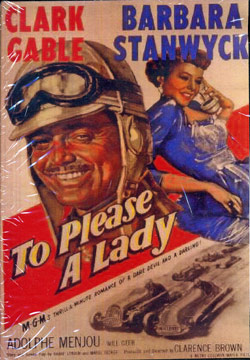|
|
|
Joyce says... Tom Cruise was not the first movie star to parlay an interest in racing into a film. But it was tough for Clark Gable to film at the Indianapolis Motor Speedway because the city was the last stop on wife Carole Lombardís war bond tour prior to being killed in a place crash. This film was the only time he ever set foot in the town in the many years following her death. If he loved racing enough to face down his own demons there (and to overlook a truly dreadful script), To Please a Lady was also a labor of somewhat misplaced love for the producer/director, too. Clarence Brown was one of the greats of his time, and he came by his interest in cars naturally, having graduated from the University of Tennessee with an engineering degree and having run his own car-building factory for a time. He certainly gives far more loving shots of the race cars here than to Ms. Stanwyck, who somehow manages to avoid phoning in her performance. Great stars, great people behind the scenes, but To Please a Lady fails as a movie because of a ludicrous story lineóone of the worst ever for a racing flick. However, the racing footage elevates it to being worthy of watching. Get popcorn or make a pit stop when Gable and Stanwyck try to breathe life into an unbelievable romanceóbut donít miss any of the racing, even the green-screen shots of Gable and Mauri Rose dueling in the 500. Itís so good, in fact, that it warrants seeing more than once. Just donít assume, even though Gable basically played the same character throughout his career, youíll see more than a hint of Rhett Butler here, because, frankly my dear, he didnít appear to give a damn. Type of Racing: Indy cars and midgets Tracks: Carroll Speedway, Los Angeles (defunct); Del Mar, California, fairgrounds (defunct, stand-in for ďGreengroveĒ); Indianapolis Motor Speedway Reel Racers: Clark Gable, Barbara Stanwyck, Will Geer Real Racers: Mauri Rose Year of Release: 1950 DVD Length: 91 minutes Approx. On-Track: 31 minutes Color/B&W: Black-and-white Watch for: . . . Not trusting the audience to root for Gableís Kyle-Busch type character, they had to make him a Congressional Medal of Honor winner. Hmmm. Maybe Kyle should take notes. . . . Stanwyck waltzes into the pit area of a midget track without so much as a challengeóand we all know that women were never allowed in the pits during the races at that time. With the dreck she had to repeat, they should have left her in the stands anyway. . . . Dialogue says the track is supposed to be heavy, but instead is smooth and hard. The devil is in the details. . . . When Stanwyck gets Gable black-balled from racing (donít worry about how), he joins Joie Chitwoodís Auto Daredevils, who are supposed to be the bottom feeders of the racing world. Wonder how Chitwood felt about it? Well, they had an actor portray him, so maybe he thought better of his cooperation. . . . Why, oh why, did the producers of that era feel the need to splice in wrecks from other tracks? . . . A lightning fast 36-second pit stop put Gable almost a lap down, but he comes back to the front in about a lap. . . . Infield admission at Indy was $3 the day of the race. You canít get more than half a hot dog for that now. . . . Mauri Roseís car caught fire during a pit stop in the real 500 race, and he calmly got back in the car after the fire was put out. That was why the producer chose to feature him prominently in the movieóand frankly, looking over his shoulder repeatedly, he shows an acting range from A to B. Which is slightly farther than Gable does. . . . The film crew spent three weeks on location at Indy filming choreographed racing, and then had six camera crews during the actual race. It was worth the effort. Some of the best Indy car racing ever committed to film. |
